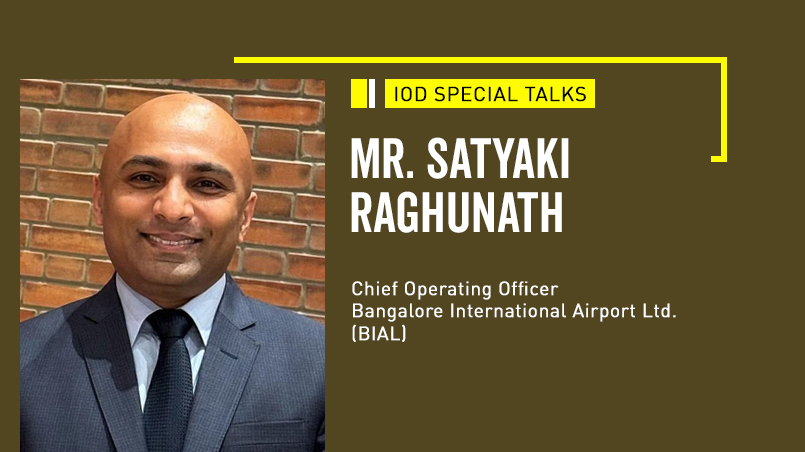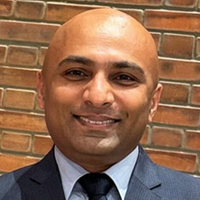 Connect with us
Connect with us

 Aug 05, 2024
Aug 05, 2024
Bangalore International Airport's Commitment to a Green Future
It's great to see you all here. Good Evening.
I work for Bangalore International Airport Ltd. (BIAL). I am assuming you all use Bangalore International Airport on a regular basis. We don't need too much introduction. We are Bangalore's Gateway; at least, we like to think of ourselves as Bangalore's Gateway. We are the third-busiest airport in India. So I'm just going to focus a little bit on our background, talk a little bit about some of the pillars that we like to think of ourselves as in terms of driving our growth, and talk about what we are doing from a sustainability perspective.
We are a public-private partnership. We are India's third-largest airport in terms of passengers and freight today. We are the only airport in South India with two independent parallel runways. We have a saturation capacity to take us somewhere between 90 and 100 million passengers per year.
In terms of growth, last year we had 37.5 million passengers, which was our busiest year. We definitely recovered from COVID. The busiest year we had before COVID was about 33.5 million passengers. We had about 245,000 movements (which essentially include takeoff and landing). We had an ASQ departure rating of 4.96 on five, which is pretty high, and we have a complaintto- compliment ratio of 1.26. But why am I saying all this? When we all opened this airport, I think many of you might remember that the airport was commissioned in May 2008, and when we celebrated our first anniversary, we had handled about 9 million passengers in the first year; when we celebrated our 10th anniversary in 2018, we had grown to 3X of the traffic, about 27 million passengers.
It is imperative for all of us to make sure that we’re doing what we need to. This means that we must focus on Climate Change, despite the fact that we are growing.
We are going to grow somewhere in the region of 3X growth, so we are going to hit somewhere between 80 and 100 million passengers by the early to mid-2030's, and all of this means that there is phenomenal growth. So when I talked about the 245,000 movements earlier, we are going to hit somewhere around 550,000 movements on our two runway systems by the early to mid-2030's. So this means that we are growing, and this has huge implications in terms of traffic, the environment, and sustainability. Therefore, it is imperative for all of us to make sure that we're doing what we need to. This means that we must focus on climate change, despite the fact that we are growing.
So we set up a sustainability vision for ourselves, which is to touch lives by nurturing a sustainable future through initiatives that drive economic, social, and environmental transformation. What do we mean by this broadly? We focus on 11 direct and 6 indirect UN SDGs, and these are global goals that many of you are familiar with. Our focus is on a number of issues, and I'm just going to skim through them.

Fundamentally, we look at the environment, community impact and development programs, government systems and policies, sustainability pillars, diversity and inclusion programs that we have adopted more recently, risk assessment and management, and privacy and data security. These are all pillars that we focus on, through our sustainability and environmental goals, as our principles.
We do that also based on the goals that I outlined, which lead to a series of strategic pillars that I will talk about very briefly. That then leads to what we call 'corporate social responsibility', but we sort of changed that theme as well; we call it 'creating social value' these days.
What are we doing in terms of the fact that we are a public utility? We are the gateway to the city; we operate a large transportation hub; and therefore, what does it mean from a community perspective to people who gave up their land, people who gave up their agricultural livelihood, to give those 4000 acres of land for the development of Bangalore Airport?
The first part is water stewardship, and we have done a lot of work on this. Over the last few years, we have really focused on what we can do with respect to making sure that we retain as much groundwater as possible. So in terms of rainwater runoff, rainwater harvesting, and things like that, we have created a series of retention ponds across the campus, and our water positivity index stands at 2.36, which means that for every liter of water we consume on the campus, we manage to store or generate 2.36 liters of water through our retention activities on the campus. This is used for a number of purposes across the campus, except for the fact that it is not used as a portable water source.
We also look at zero carbon emissions, which is something we are working towards. We have not gotten there yet, but I'm pleased to say that for the last four years, Bangalore airport has been 100% powered by renewable energy, which is something we are very proud of. It's a combination of solar and wind energy that powers the airport. We are trying to take more and more steps in order to go towards zero carbon emissions. We have a solid waste management plant now, so we will have zero disposal in landfills by the end of this year. We use a lot of recycled plastic in the development of our roads and a number of other initiatives across the campus.
We look at a number of community-aligned noise management issues, and this is something that we just started because earlier we were in the midst of nowhere. When the airport started off, in fact, as many of you would recall, most people were complaining about the fact that to get to the airport, it took them 30 kms. Even though we didn't choose the site, we get a lot of complaints. Having said that, the 245,000 movements that we have and the fact that it's going to grow to 550,000 movements mean that there is going to be more noise. This means that the communities around there are going to have to deal with some of these noise elements, and so we are working to see what we can do with respect to that.
The fourth one is the circular economy, which means that everything that we do—how can we think about innovation? How can we think about project delivery? How can we think about a number of our initiatives with respect to business, society, and the environment?? Can we do it more sustainably? Can we do things both upstream and downstream that will diminish the impacts of what we do from an environmental and sustainability perspective? These are all conversations that we have all the time.
We are the gateway, and growth is imperative, as I say, but at what cost? What can we do in order to make sure that that growth is not coming in a way that is detrimental to the rest of society? This is something that we take seriously.
We are also looking at sustainable procurement in terms of what we can do through our procurement processes to make sure that we are procuring every one of our services, goods, materials, and so forth through as sustainable means as possible. We moved to a completely paperless environment across Bangalore airport. We have everything done through an app now, so there's no more use of paper. This is not just across our enterprise, but we are sort of moving to it across all of our concessionaires as well. In fact, we were the first airport in India where the entire cargo community went paperless. So, today, you don't need any paperwork to go to the cargo community to do freight. We have a cargo community app, and everything is tracked on a mobile app, and you get direct live information if you are shipping something through Bangalore airport.
The sixth one is sustainable mobility, and this is kind of interesting. I think that one of the common criticisms we get again is that we are 30 kms away, so how do we get to the airport? This is a common refrain among most Bangalorians.
So the idea is, what can we do to make sure that we move and get to and from the airport in as sustainable a way as possible? Well, the good news is that the Metro is coming, and the Metro is going to be there by 2026–27. In the meantime, we have also taken a number of initiatives to make sure we are moving more and more to a fleet of EVs. A lot of our own fleet at Bangalore airport is powered by electrical power. We are now moving towards the taxi service, where you can use 'Blue Smart' and EVs to get to and from the airport. We are trying to push any of our concessionaires to drive towards sustainable mobility, and over the course of time, we are trying to push everybody more and more to drive towards public transport.
Today, we have 22% of our passengers who get to and from the airport using public transport. That's primarily using the 'Vayu Vajra Services' and things like that, but we are hopeful that it will be in excess of 30–35% once the Metro comes and we will have significant ridership.
We are also working with the Karnataka government in order to get KRIDE and suburban rail at the airport. We have a station at the airport even today. It's on the northwest corner of the airport, and there are services. I think there needs to be a lot more services with greater frequency in order to have an impact on sustainable mobility, but it is something that we are targeting.
We are working with our partners, concessionaires, and ground handlers to also move towards electronic vehicles, and we are trying to see what we can do in order to move away completely from fossil fuels.
There are also three core foundational values that we believe in with respect to CSR, compliance, and behavioral changes, and this is something that we take very seriously at the enterprise level.
What we've done is try to work as much as possible with the communities around Bangalore airport. As I said, they gave up their land and livelihoods for the airport to come up, and therefore we do a significant amount of work with the schools in and around the airport in order to make sure that we can give them the education that their children need. We work on clean water and sanitation, and we work on the curriculum and the development of these schools. These schools are actually much nicer than the ones I went to as a child. They are built on the same principle that we use to design our buildings. They are powered by renewable energy. They have CCTV in terms of security and to monitor what goes on at the schools. They get clean water, and we provide the meals. We provide the curriculum, and we work with the teachers in terms of not just the curriculum but also teacher training and making sure that the performance of the school is as per standards.
I think what gives us the greatest pleasure and gratification is the fact that, over the course of the last few years, my understanding is that these six schools have gone to the third position in Karnataka state government results. So I think from that perspective, we are working through all of our communities in order to make sure that this airport is something that represents not just Bangalore but also the local communities in and around Bangalore.
As they say, I think for us the biggest success is the fact that most people in Bangalore today, including our employees, really feel a sense of pride in the fact that they represent the city of Bangalore. We think of it as Nimma Airport (your airport), not just Namma Airport (our airport). I think that we take that exceptionally seriously.
We believe that our success is based on the fact that most of Bangalore feels proud about the fact that there is a world-class infrastructure asset here that does so much both for the community and sustainability, and as we continue to grow, these are principles that we will think about and adhere to.
I hope to have more discussions as we move along. Thank you.

Excerpts from the 'Special Address' delivered by Mr. Satyaki Raghunath, Chief Operating Officer, Bangalore International Airport Ltd. (BIAL) in th 'Session-IV' of the 25 International Conference on Environment Management and Climate Change, held on June 27, 2024 in Hotel The Lalit Ashok, Bengaluru.
Owned by: Institute of Directors, India
Disclaimer: The opinions expressed in the articles/ stories are the personal opinions of the author. IOD/ Editor is not responsible for the accuracy, completeness, suitability, or validity of any information in those articles. The information, facts or opinions expressed in the articles/ speeches do not reflect the views of IOD/ Editor and IOD/ Editor does not assume any responsibility or liability for the same.
About Publisher

Bringing a Silent Revolution through the Boardroom
Institute of Directors (IOD) is an apex national association of Corporate Directors under the India's 'Societies Registration Act XXI of 1860'. Currently it is associated with over 30,000 senior executives from Govt, PSU and Private organizations of India and abroad.
View All BlogsMasterclass for Directors
Categories